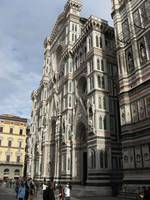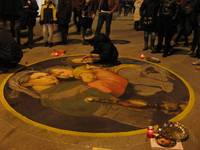The sights in Firenze (Florence)
January 1st, 2009 at 8:15 pm (Italian, Travel)
 On the advice of our excellent local guide, we took the train to Florence on Sunday. It was just over an hour’s ride through a series of small towns (Empoli seemed to be the largest one). After arriving, we walked straight over to the massive Cathedral (Santa Maria del Fiore). It was closed (having mass) so we walked around some more and admired the absolutely awe-inspiring exterior (composed of different kinds of stone/marble in white, red, and green and with much elaborate carving). Words really cannot capture just how magnificent this building is. I bought some writing paper for friends back home (questi, per favore), and then sat down to write postcards. The wind was kicking up and it was a bit chilly in the shade. We got lunch at a pizzeria, and for dessert I got to taste absinthe-flavored chocolate for the first time (I have no idea if this is common in Italy). It taste like a spicy kind of licorice.
On the advice of our excellent local guide, we took the train to Florence on Sunday. It was just over an hour’s ride through a series of small towns (Empoli seemed to be the largest one). After arriving, we walked straight over to the massive Cathedral (Santa Maria del Fiore). It was closed (having mass) so we walked around some more and admired the absolutely awe-inspiring exterior (composed of different kinds of stone/marble in white, red, and green and with much elaborate carving). Words really cannot capture just how magnificent this building is. I bought some writing paper for friends back home (questi, per favore), and then sat down to write postcards. The wind was kicking up and it was a bit chilly in the shade. We got lunch at a pizzeria, and for dessert I got to taste absinthe-flavored chocolate for the first time (I have no idea if this is common in Italy). It taste like a spicy kind of licorice.
 We then entered the cathedral (which, surprisingly, did not have an entry fee). The inlaid stone floor was breathtaking, with a variety of different geometric and flowery patterns. There is also a 24-hour clock! (It wasn’t set to the right time, though.) The famous frescoed dome was difficult to get a good view of because the front of the church was roped off for the 6 p.m. mass (we think). We did see a painting/homage to Dante Alighieri, and we went downstairs to the giftshop next to the tomb of the dome’s architect. Sadly, a new archaeological dig area, also downstairs, was not yet open to the public.
We then entered the cathedral (which, surprisingly, did not have an entry fee). The inlaid stone floor was breathtaking, with a variety of different geometric and flowery patterns. There is also a 24-hour clock! (It wasn’t set to the right time, though.) The famous frescoed dome was difficult to get a good view of because the front of the church was roped off for the 6 p.m. mass (we think). We did see a painting/homage to Dante Alighieri, and we went downstairs to the giftshop next to the tomb of the dome’s architect. Sadly, a new archaeological dig area, also downstairs, was not yet open to the public.
We exited and wandered over to a plaza where there were many statues (copy of David, Neptune, others) and annoying American music blasting from a tent. We went into an art display which was by Jorge Eielson, mainly about knots (best approximation I could find online). I’m not a huge fan of modern art, but knots intrigue with their combination of very organic appearance and mathematical/topological properties.
 From there, we wandered some more, past a series of excellent statues (Leonardo! Galileo! Macchiavelli!) and to the Ponte Vecchio (Old Bridge), which has buildings hanging off it over the river, and seems mostly to be very old storefronts that now feature only jewelry. We crossed to the other side of the river and had some divine (and expensive) hot chocolate (cioccolata calda). We saw a carousel, street performers, street hawkers, and chalk artists. We had dinner at a nice place with a somewhat snooty waitress. I ordered in Italian (yay!), ravioli di ricotta e spinace with butter and sage (memory fails me now, sigh!).
From there, we wandered some more, past a series of excellent statues (Leonardo! Galileo! Macchiavelli!) and to the Ponte Vecchio (Old Bridge), which has buildings hanging off it over the river, and seems mostly to be very old storefronts that now feature only jewelry. We crossed to the other side of the river and had some divine (and expensive) hot chocolate (cioccolata calda). We saw a carousel, street performers, street hawkers, and chalk artists. We had dinner at a nice place with a somewhat snooty waitress. I ordered in Italian (yay!), ravioli di ricotta e spinace with butter and sage (memory fails me now, sigh!).
We headed back to the train and discovered that the one we’d wanted to take at 8:27 p.m. didn’t run on Sundays. But we got a slower train at 8:37 that got us into the Pisa station at 9:59 p.m. One challenge with Italian train travel seems to be that they don’t bother to announce stops or put signs at all of the stations… and especially at night, it can be difficult to know if you’ve reached your stop yet. When we got off at what we figured was Pisa, I quickly asked someone “Mi scuzi, dove è?” (“Excuse me, where is?”) because I couldn’t remember how to conjugate “to be” (essere) into the plural second person to ask “where are we?”. I got a blank look and then a response: “Dove siamo?” which of course is the correct way to say it, and I nodded and said, “Pisa?” and he said, “Si!”, so we didn’t need to jump back on the train. :)
Another highlight of the train trip was observing an argument between one passenger and another, who was inebriated or otherwise impaired and about to light a cigarette underneath the vietato fumare (no smoking) sign. I couldn’t understand at all what was being said, but body language and tone of voice and gestures said it all. The argument grew increasingly vehement, until the train stopped at the next station and the complainer stood up and physically escorted the smoker off the train. The complainer returned and the train moved on… leaving the smoker out in the cold. I was in awe. :)
A short walk back to the Hotel Bologna, and I was able to check in at last. I almost managed this in Italian, but choked on pronouncing bagaglio (luggage). Anyway, I ended up in a fantastic room, which came with slippers. Luxury!


 I’ve been making steady progress with my Italian podcasts: please (per piacere or per favore) and thank you (grazie), days of the week (oggi è giovedì!), numbers (up to 100), Merry Christmas (Buon Natale! Clearly I’m still working my way towards the present in podcast-land). I’ve also been picking up more vocabulary through
I’ve been making steady progress with my Italian podcasts: please (per piacere or per favore) and thank you (grazie), days of the week (oggi è giovedì!), numbers (up to 100), Merry Christmas (Buon Natale! Clearly I’m still working my way towards the present in podcast-land). I’ve also been picking up more vocabulary through